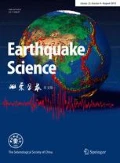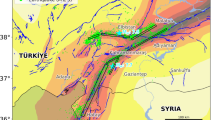Abstract
The coseismic Coulomb stress change caused by fault interaction and its influences on the triggering and delaying of earthquake are briefly discussed. The Xianshuihe fault belt consists of Luhuo, Daofu, Kangding, Qianning and Ganzi fault. Luohuo (M S=7.6, 1973)-Kangding (M S=6.2, 1975)-Daofu (M S=6.9, 1981)-Ganzi (M S=6.0, 1982) earthquake is a seismic sequence continuous on the time axis with magnitude greater than 6.0. They occurred on the Luhuo, Kangding, Daofu and Ganzi fault, respectively. The coseismic Coulomb stress changes caused by each earthquake on its surrounding major faults and microcracks are calculated, and their effects on the triggering and delaying of the next earthquake and aftershocks are analyzed. It is shown that each earthquake of the sequence occurred on the fault segment with coseismic Coulomb stress increases caused by its predecessors, and most aftershocks are distributed along the microcracks with relatively larger coseismic Coulomb stress increases resulted from the main shock. With the fault interaction considered, the seismic potential of each segment along Xianshuihe fault belt is reassessed, and contrasted with those predicted results ignoring coseismic Coulomb stress change, the significance of fault interaction and its effect on triggering and delaying of earthquake are emphasized. It is concluded that fault interaction plays a very important role on seismic potential of Xianshuihe fault belt, and the maximal change of future earthquake probability on fault segment is up to 30.5%.
Similar content being viewed by others
References
Cornell C A. 1993. Seismic hazard induced by mechanically interactive fault segments [J]. Bull Seism Soc Amer, 83: 436–449.
FU Zheng-xiang, LIU Gui-ping. 1999. Visco-elastic model of interaction between parallel strike-slip faults and seismicity reduction effect [J]. Earthquake, 19(2): 127–134.
FU Zheng-xiang, LIU Gui-ping, CHEN Qi-fu. 2001. Dynamic analysis on interaction between the Haiyuan-Gulang-Changma great earthquake in the north boundary of the Tibetan plateau [J]. Seismology and Geology, 23(1): 35–42.
Gomberg J, Ellis M. 1993. 3D-Def: A User’s Manual [R]. USGS open-file report, 93–547.
Gomberg J, Ellis M. 1994. Topography and tectonics of the New Madrid seismic zone: results of numerical experiments using a three-dimensional boundary element program [J]. J Geophys Res, 99: 20 299–20 310.
Harris A R, Simpson R W, Reasenberg P A. 1995. Influence of static stress changes on earthquake locations in Southern California [J]. Nature, 375: 221–224.
Hashimoto M. 1997. Correlation to “Static Stress changes associated with the Kobe earthquake: calculation of changes in Coulomb failure function and comparison with seismicity change” [J]. J Seism Soc Japan, 50: 21–27.
Hodgkinson K M, Stein R S, King G C P. 1996. The 1954 Rainbow Mountain — Fairview Peak — Dixie Valley earthquake: A triggered normal faulting sequence [J]. J Geophys Res, 101: 25 459–25 471.
Jaeger J C, Cook N H W. 1976. Fundamentals of Rock Mechanics (The 2nd edition) [M]. London: Chapman and Hall Press, 1–56.
King G C P, Stein R S, Lin J. 1994. Static stress change and the triggering of earthquake [J]. Bull Seism Soc Amer, 84: 935–953.
LIU Gui-ping, FU Zheng-xiang. 2000. Regional seismicity triggered by the M s=7.8 Tangshan event on July 28, 1976 and the static stress field change. Acta seismologica sinica, 13(1): 19–28.
LI Ping. 1993. Xianshuihe-Xiaojiang Fault Belt [M]. Beijing: Seismological Press, 1–259.
LI Tian-zhao. 1997. Seismic Potential Assessment of Xianshuihe Fault Belt [M]. Chengdu: Chengdu Catographical Press, 1–125.
Okada Y. 1985. Surface deformation due to shear and tensile faults in a half-space [J]. Bull Seism Soc Amer, 75: 1 135–1 154.
Okada Y. 1992. Internal deformation due to shear and tensile faults in a half-space [J]. Bull Seism Soc Amer, 82: 1 018–1 040.
Reasenbeg P A, Simpson R W, 1992. Response of regional seismicity to the static stress change produced by the Loma Prieta earthquake [J]. Science, 255:1 687–1 690.
Seismological Bureau of Sichuan Province. 1988. Xianshuihe Fault Belt [M]. Chengdu: Sichuan Scientific and technological Press, 1–265.
Stein R S, King G C P, Lin J. 1994. Stress triggering of the 1994 M=6.7 Northridge, California, Earthquake by its predecessors [J]. Science, 265: 1 432–1 435.
Stein R S, Barka A A, Dieterich J H. 1997. Progressive failure on the North Anatolian fault since 1939 by earthquake stress triggering [J]. Geophys J Intl, 128: 594–604.
Toda S, Stein R S, Reasenberg P A, et al. 1998. Stress transferred by the 1995 M w=6.9 Koba, Japan, shock: effect on aftershock and future earthquake probability. J Geophys Res, 103(B10): 24 543–24 565.
WEN Xue-ze. 1995. Quantitatively Assessment of Seismic Potential of Active Fault [M]. Beijing: Seismological Press, 1–146.
WEN Xue-ze. 1996. Ten-year probabilistic seismic hazard assessment along major active strike-slip fault in western Sichaun Province [J]. Research on Active Fault, 5: 11–26.
ZHANG Guo-ming, LI Li. 1997. Interaction of strong earthquakes in the process of their preparation and occurrence [J]. Earthquake, 17(7): 221–231.
ZHANG Qiu-wen, WANG Cheng, ZHANG Pei-zhen, et al. 2001a. Earthquake triggering and delaying caused by fault interaction [A]. Proceedings of 2000’ Chinese Postdoctor Academic Conference [C]. Beijing: Scientific Press. 354–359.
ZHANG Qiu-wen, ZHANG Pei-zhen, WANG Yi-peng, et al. 2001b. Preliminary research on fault interaction and its influences on seismic potential of active fault [J]. Research on Active Fault, 8: 41–49.
ZHANG Qiu-wen, ZHANG Pei-zhen, Wang Cheng, et al. 2002. Quasi-periodically clustering earthquake recurrence in some seismotectonic belts in China continent [J]. Journal of Geodesy and Geodynamics, 22(1): 56–62.
ZHANG Zhi-li. 1987. Mechanical analysis and application of fault system generating and expanding process [J]. Science in China, 11: 1 214–1 224.
Author information
Authors and Affiliations
Additional information
Foundation item: State Natural Science Foundation of China (No49834002), United foundation of Seismological Science (No100061) and Key Project of China Seismological Bureau (No95041007).
About this article
Cite this article
Zhang, Qw., Zhang, Pz., Wang, C. et al. Earthquake triggering and delaying caused by fault interaction on Xianshuihe fault belt, southwestern China. Acta Seimol. Sin. 16, 156–165 (2003). https://doi.org/10.1007/s11589-003-0018-5
Received:
Revised:
Accepted:
Issue Date:
DOI: https://doi.org/10.1007/s11589-003-0018-5
Key words
- coseismic Coulomb stress change
- fault interaction
- earthquake triggering and delaying
- seismic potential assessment
- Xianshuihe fault belt




